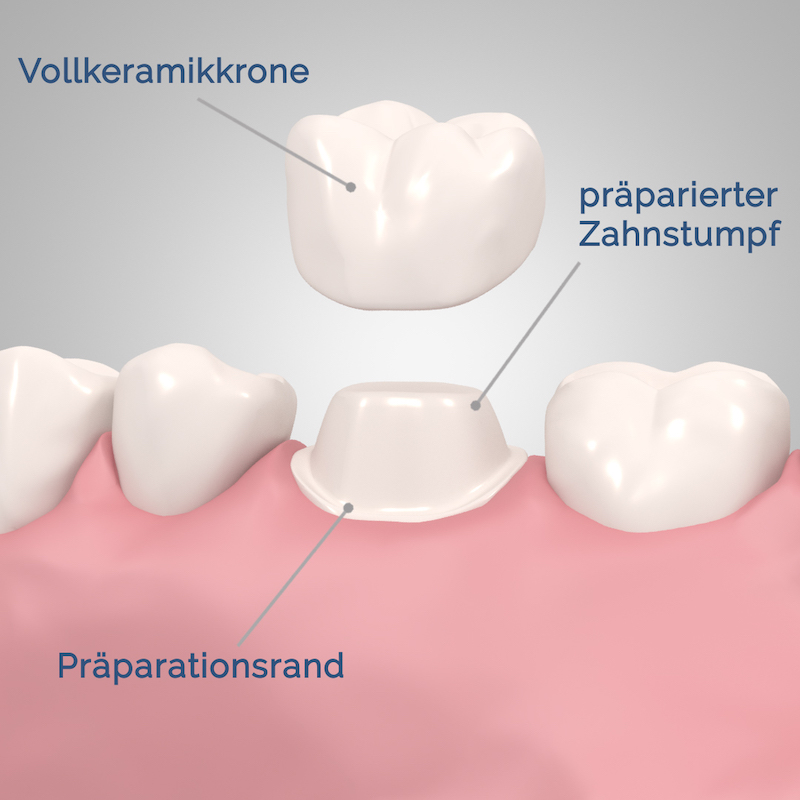Dental crowns and bridges
Dental crowns and bridges – just perfect prosthetics
Similar to a fingerprint, every set of teeth is different and therefore unique. Crowns, bridges and the like are therefore masterpieces of prosthetics that have to fit with millimetre precision.
Dentures are therefore always customised to your anatomy with the precision of a Swiss watch, like a fine suit.
Again and again, patients visit our practice with the desire for beautiful, bright teeth and the perfect smile.
In order to fulfil this wish, careful and comprehensive planning is required, whereby close cooperation between patient, dentist and – last but not least – the dental laboratory has top priority. Our specialists in aesthetic dentistry, MSc MSc Planert and Dr Viktorov, have access to our in-house, state-of-the-art dental laboratory. We can offer our patients all available treatment options that are based on the latest standards of modern aesthetic dentistry and thus guarantee you the best possible treatment for “your perfect smile”.
If much of the tooth structure has been lost – usually due to the extensive destruction of teeth by caries and there is no possibility of anchoring fillings securely in the tooth – the tooth must be restored with dentures for reasons of stability.

Dental crowns
Teeth that have previously undergone successful root canal treatment are often restored with a crown. These teeth usually have little remaining tooth substance and can therefore break off. By crowning these teeth, the chewing force is transferred to the root and the surrounding periodontium, thus protecting the tooth and preserving it in the long term.
If the entire natural enamel layer is replaced, this is referred to as a (artificial) full or shell crown; if the enamel is only partially removed, this is referred to as a partial crown. The transitions between full and partial crowns as well as the multi-surface inlay fillings (inlay, onlay, overlay) are fluid.

This makes it possible to achieve and guarantee a predictable restoration of the teeth with the highest aesthetic standards.
Steps of the treatment
How much tooth structure needs to be removed when preparing the tooth essentially depends on three factors. Priority is given to protecting the pulp, i.e. a sufficiently thick layer of healthy tooth substance must generally remain above the pulp. Aesthetics and crown material also play an important role. Basically, as much tooth structure must be removed as is necessary to rebuild the tooth and make it look good at the same time.
An impression of the tooth stump is then taken, which is used by the dental technician to make the crown or bridge individually and accurately. The fabrication of the dentures usually takes 2 weeks. Until the final restoration is completed, the tooth stump is treated with a temporary restoration (plastic crown or bridge) so that you can continue to smile carefree. It also serves to hold the ground tooth in position, to protect the tooth stump from stimuli – such as heat or cold – and to prevent the bite from changing.
Bridges
Thanks to our interdisciplinary practice concept, we can guarantee affected patients the best possible treatment from a wide range of treatment options in order to replace their missing teeth.
For us, all-ceramic is also the material of choice for bridge restorations, whether the bridge abutments are teeth or implants. The basic framework of the bridge is made of zirconium ceramic, which is extremely strong and stable. However, this zirconium ceramic has aesthetic deficits, so the bridge frameworks are coated with a slightly softer ceramic material that resembles the appearance and strength of natural teeth.
However, this “white aesthetic” is only one part of our complex treatment concept. The second essential part of a perfect natural reconstruction is the “red aesthetics”, i.e. the natural adaptation of the dentures to the gums. The preparation of the abutment teeth with consideration for the surrounding gums – using magnifying glasses – is just as important and necessary as the thickening of the gums in the area of the bridge pontic using so-called connective tissue grafts.
Advantages of crowns and bridges
You can continue to chew efficiently because the fine control of the masticatory system remains intact. The chewing surfaces of a tooth are rebuilt precisely and permanently. The durability of crowns and bridges is very good, i.e. they have a long service life.
Conclusion
“The result of our endeavours should always be the smile of our patients: as perfect as you would like it to be!”
Which dentures are right for me?
Together we discuss the advantages and disadvantages of all variants. We make recommendations and work with you to find the right option for you. Your personal wishes take centre stage.
A dental technician will manufacture the dentures customised to your oral situation. Leipziger14-Ihre Zahnärzte has its own in-house dental laboratory. This enables us to ensure that communication between dentist and dental technician runs smoothly and that all work processes can be implemented efficiently.
Patient OPINIONS
Great doctor
Thorough diagnosis; honest recommendation not to carry out the planned special treatment in my case, thus saving me unnecessary treatment costs.
Friendly and competent
I felt safe and in good hands from the very first moment. Dr Planert took the time to answer my questions and explained everything clearly.
Outstanding!
I am completely satisfied! Very courteous reception... Advice and treatment at a very high level. Can recommend Leipziger14-Ihre Zahnärzte and Mr Planert with a clear conscience!"
Great doctor
Thorough diagnosis; honest recommendation not to carry out the planned special treatment in my case, thus saving me unnecessary treatment costs.
Outstanding!
I am completely satisfied! Very courteous reception... Advice and treatment at a very high level. Can recommend Leipziger14-Ihre Zahnärzte and Mr Planert with a clear conscience!"
Friendly and competent
I felt safe and in good hands from the very first moment. Dr Planert took the time to answer my questions and explained everything clearly.

